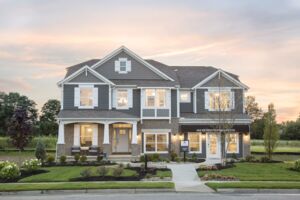
The Best Home Builders in Cincinnati
Posted by Patrick Begg in Home Buying
Sunny and warm are probably the first two words that come to your mind when someone mentions the climate of Florida.
You’ll even find within the state there are different climates: distinct tropical climate in the South and humid subtropical climate in the central and northern part of this state. Some periods of the year are rainy while others are dry.
But, if there is one characteristic of Florida weather that is pretty consistent, it has to be the heat. And it’s our lovely hot and humid heat that is a giant determining factor of the best materials to build a house in Florida.
With wood frame construction, the exterior walls are shaped with 2’ x 6’ studs. They are supported on the top and bottom, where the stud sits on a pressure treated piece of wood that is anchored to the concrete slab for support. The actual walls, made of OSB (a type of engineered wood) or plywood, are attached to the studs.
Blocks exterior walls are laid on top of the slab, and mortar (a paste-like mix) is used to hold the blocks together. Then, some of the empty cells of the block are filled with concrete. This holds the vertical rebar in place which gives the walls even more strength. A concrete lintel—a horizontal structural component that goes across the top of the opening—ties everything together.
Both the above exterior walls are then finished with stucco, siding, brick, or stone, which are really just decorative accents. The same trusses (wood structures that support the roof), sheathing (the wood boards that go on top of the trusses that the shingles attach to), and interior walls are used either way.
That may depends on who you ask and where you are building. While using block might take longer to build and be less cost-effective than using frame, it is more energy efficient, more resistant to moisture, and is less likely to support the growth of mold and mildew, which is super important here in our hot and humid climate!
The interior walls of most Florida homes are framed with wood. The thickness of the wall depends on its purpose. Normal interior walls are a different thickness than those containing plumbing or air ducts. All the wiring, electric, and cable run through and down the side of these studs, but don’t worry, everything gets covered by the drywall. The bottoms of these studs are treated for termites, so you might see a greenish stain on the bottom three or four feet.
The actual walls are built of drywall. The drywall is screwed to the wood studs, and the seams are covered by tape and then mudded. But wait! Before the walls can be closed up they need to have a few more things added.
Using the best insulating building materials available is the most effective way to keep the Florida heat out of your home while keeping your home comfortable and optimizing energy efficiency. Different types of insulation should be used in different parts of your home.
We all know heat rises, so it’s super important to pay close attention to the material used in the attic. For this space, blown-in insulation is a great choice.
Unlike rolled batting, blown insulation is smaller and able to fill in the tiny crevices throughout your attic where air typically leaks through, creating a superior seal.
Radiant Barrier is the most effective at preventing heat from entering a structure, making it most useful in warmer climates. This type of product, attached to the underside of the roof decking, increases R-value, offers greater comfort, and helps maintain a more consistent temperature by reflecting 95% of the radiant heat back out of the attic. By insulating this space correctly you will be able to let the temperature distribute better throughout the home properly.
Batted insulation is ideal between the studs of some interior walls. Don’t forget to insulate your exterior walls! Additional Insulation pumped into your block wall is a good solution. It not only delivers excellent air sealing for energy savings and increased R-factor, but it also provides increased sound insulation, fire retardant, and pest prevention.
Chris Cangialosi, one of M/I Homes’ Area Construction Managers offers some expert advice for homeowners: “One of the biggest mistakes that builders make is not addressing the hollow cores in cinderblock. It’s a missed opportunity.”
Make sure you know what is being used on your new home to ensure you will have the best building materials for our hot climate and that the right amount of insulation has been installed properly in the required areas.
The largest consumer of energy in most Florida homes is the heating, ventilation, and air conditioning (HVAC) system. This can account for more than 40% of your home’s energy usage and, therefore, more than 40% of your utility bill!
Your air ducts, air vents, and air returns regulate the temperature throughout your home. Each room should also have its own air return, which keeps your home’s air temperature balanced.
We don’t have to worry about using our heat too much in Florida, but when we do, we use electric heat pumps. While they are not the most efficient in temps below freezing, they allow your system to run in its most efficient state most of the time.
While the paint used on the outside of your home isn’t behind your walls, it’s still worth mentioning. After the crazy 2004 tropical season where Florida experienced never-before-seen water penetration through block walls, the use of elastomeric paint became super popular. It helps keep wind-blown rain from penetrating the out wall of the home.
The word “home” conjures up warm and cozy feelings and is a place we should be able to enjoy and make wonderful memories in. For that reason, building a safe and durable home with the best building materials available is so important. Make sure you are well-informed of the materials used for your home to ensure that it protects those in it.

Blog Author
Patrick Begg is a seasoned capital markets and risk management professional for M/I Financial, bringing over 35 years of expertise in navigating the complexities of secondary mortgage markets, structured finance, and comprehensive risk management strategies. Throughout his career, Patrick has demonstrated a deep understanding of market dynamics and a keen ability to adapt to the evolving landscape of mortgage finance. He remains passionate about staying ahead of trends in interest rate movements and regulatory shifts, ensuring strategic alignment in an ever-changing financial environment.
The Best Home Builders in Cincinnati
The Best Home Builders in Tampa, FL

Blog Author
Patrick Begg is a seasoned capital markets and risk management professional for M/I Financial, bringing over 35 years of expertise in navigating the complexities of secondary mortgage markets, structured finance, and comprehensive risk management strategies. Throughout his career, Patrick has demonstrated a deep understanding of market dynamics and a keen ability to adapt to the evolving landscape of mortgage finance. He remains passionate about staying ahead of trends in interest rate movements and regulatory shifts, ensuring strategic alignment in an ever-changing financial environment.


